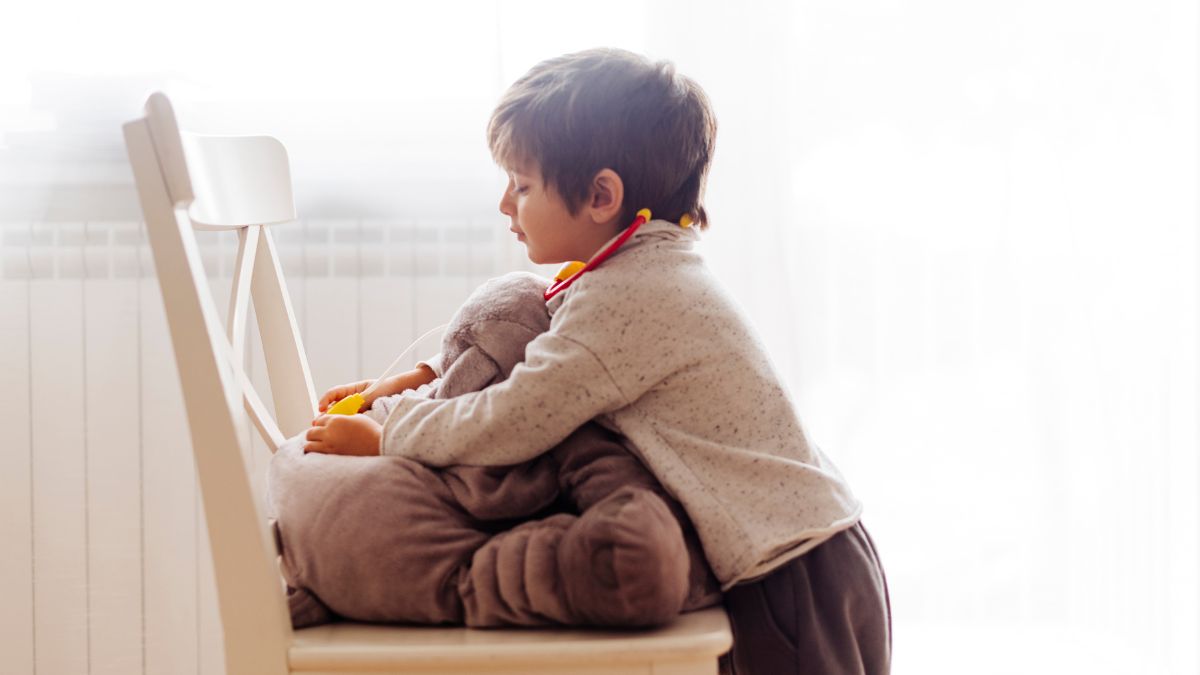Social Anxiety vs. Autism Demystified

Understanding Social Anxiety
Social anxiety is a common mental health condition that affects individuals in social situations. It is important to distinguish social anxiety from other disorders, such as autism, as they have distinct characteristics and treatment approaches. Let's delve into the definition, symptoms, causes, and triggers of social anxiety.

Definition and Symptoms
Social anxiety, also known as social phobia, refers to an intense fear of social situations where an individual may be scrutinized or judged by others. People with social anxiety often experience excessive self-consciousness and fear of embarrassment or humiliation in social settings.
The symptoms of social anxiety can vary from person to person but commonly include:
- Intense anxiety or fear in social situations
- Avoidance of social interactions or situations
- Physical symptoms like rapid heartbeat, sweating, trembling, or shortness of breath
- Negative thoughts and self-criticism before and after social encounters
These symptoms can significantly impact an individual's daily life, relationships, and overall well-being.
Causes and Triggers
The exact causes of social anxiety are not fully understood. However, several factors may contribute to its development. These can include:
- Genetic predisposition: Some individuals may have a genetic vulnerability to developing social anxiety, as it can run in families.
- Brain structure and chemistry: Differences in brain structure and the functioning of certain neurotransmitters, such as serotonin, may play a role in social anxiety.
- Environmental factors: Traumatic or negative experiences, such as bullying or embarrassment in social situations, can contribute to the development of social anxiety.
Triggers for social anxiety can vary but commonly involve situations that involve social interactions, such as public speaking, meeting new people, or being the center of attention. These triggers can evoke intense anxiety and a strong desire to avoid such situations.
Understanding the definition, symptoms, causes, and triggers of social anxiety is crucial for differentiating it from other conditions, like autism. In the following sections, we will explore autism in detail to further clarify the distinctions between these two disorders.
Understanding Autism
Autism is a neurodevelopmental disorder that affects individuals in various ways. It is characterized by differences in social interaction, communication, and behavior. Understanding the definition and characteristics of autism, as well as the diagnosis process and the spectrum of autism, is essential for gaining insight into this condition.
Definition and Characteristics
Autism, also known as Autism Spectrum Disorder (ASD), is a complex developmental condition that typically appears in early childhood. It affects individuals' abilities to communicate, interact socially, and perceive the world around them. The exact causes of autism are still being studied, but it is believed to involve a combination of genetic and environmental factors.
Some common characteristics of autism include:
- Challenges in social interaction: Individuals with autism may struggle with understanding social cues, making eye contact, and forming and maintaining relationships. They may have difficulty understanding and responding to the emotions and social behaviors of others.
- Communication differences: Communication difficulties are a hallmark of autism. Some individuals may have delayed language development, while others may have difficulty using and understanding non-verbal communication, such as gestures and facial expressions. Some individuals may also exhibit repetitive or restrictive speech patterns.
- Restricted and repetitive behaviors: Many individuals with autism engage in repetitive behaviors or have specific interests that they focus on intensely. They may adhere to strict routines and may become distressed in the face of change. Sensory sensitivities, such as being overly sensitive to certain sounds, textures, or lights, are also common.
Diagnosis and Spectrum
Diagnosing autism involves a comprehensive evaluation conducted by healthcare professionals, such as psychologists, psychiatrists, or developmental pediatricians. The evaluation typically includes observing the individual's behavior, communication, and social interactions. It may also involve interviews with the individual and their parents or caregivers.
Autism exists on a spectrum, which means that it encompasses a wide range of symptoms and levels of functioning. The spectrum includes individuals with varying degrees of impairment in social interaction, communication, and behavior. Some individuals may have milder symptoms and require less support, while others may have more significant challenges that require more intensive interventions and support.
It's important to note that each person with autism is unique, and their experiences and abilities can vary greatly. The spectrum recognizes this diversity and emphasizes the need for individualized support and interventions tailored to each person's specific needs.
Understanding the definition, characteristics, diagnosis, and spectrum of autism is crucial for recognizing and supporting individuals with this condition. By promoting awareness and acceptance, we can create a more inclusive society that embraces the strengths and uniqueness of individuals with autism.
Key Differences
When comparing social anxiety and autism, it's important to understand the key differences that exist between these two conditions. While they may share some overlapping traits, they are distinct in terms of social interaction challenges and communication variances.
Social Interaction Challenges
One of the primary differences between social anxiety and autism lies in the nature of social interaction challenges experienced by individuals with these conditions. In social anxiety, individuals typically have an intense fear or anxiety about social situations. They may feel self-conscious, worried about being judged, or fear embarrassing themselves. As a result, they may avoid social situations altogether or endure them with significant distress.
On the other hand, individuals on the autism spectrum often face challenges in social interactions due to difficulties with social communication and understanding social cues. They may struggle with initiating or maintaining conversations, interpreting nonverbal cues, and understanding social norms. These challenges are not driven by fear or anxiety but rather arise from differences in social cognition and processing.
Communication Variances
Another notable difference between social anxiety and autism lies in the variances in communication skills. Individuals with social anxiety typically do not experience significant difficulties in their ability to communicate verbally. While they may feel anxious or self-conscious in social situations, they can effectively express themselves and understand others when their anxiety is not overpowering.
In contrast, individuals with autism often exhibit communication variances that go beyond social anxiety. These variances can include delayed language development, difficulty with speech articulation, and challenges in understanding and using nonverbal communication cues such as gestures and facial expressions. Communication difficulties in autism are not solely related to anxiety but are intrinsic to the condition itself.
Understanding these key differences can help in distinguishing between social anxiety and autism. It is crucial to keep in mind that each condition requires specific approaches to diagnosis and treatment, and seeking professional guidance is essential to obtain an accurate assessment and appropriate support.
Overlapping Traits
While social anxiety and autism are distinct conditions, there are certain traits that can overlap between the two. These overlapping traits include sensory sensitivities and behavioral patterns.
Sensory Sensitivities
Both individuals with social anxiety and autism may experience heightened sensitivity to sensory stimuli. This sensitivity can manifest in various ways, including hypersensitivity or hyposensitivity to certain sounds, textures, smells, or visual stimuli.
In the case of social anxiety, sensory sensitivities can intensify feelings of discomfort or anxiety in social situations. For example, crowded or noisy environments may be overwhelming for individuals with social anxiety, leading to heightened stress and avoidance of such situations.
Similarly, individuals on the autism spectrum often have sensory sensitivities that can impact their daily lives. They may struggle with sensory overload, finding it challenging to filter or process sensory information. This can result in anxiety, meltdowns, or withdrawal from overwhelming sensory environments.
Behavioral Patterns
Another area of overlapping traits between social anxiety and autism is the presence of certain behavioral patterns. While these patterns can manifest differently in each condition, there are similarities in certain aspects.
Individuals with social anxiety may exhibit avoidant behaviors, such as avoiding social interactions or situations that trigger anxiety. They may also display excessive self-consciousness, worry about being negatively judged, or fear of embarrassing themselves in social settings.
On the other hand, individuals on the autism spectrum may also display avoidant behaviors, but these behaviors are often driven by difficulties with social communication and interaction. They may struggle with understanding social cues, maintaining eye contact, or engaging in reciprocal conversation. These challenges can lead to social withdrawal or difficulties in building and maintaining relationships.
It's important to note that while there may be overlapping traits between social anxiety and autism, a thorough evaluation by a qualified professional is necessary to accurately diagnose and differentiate between the two conditions. Each condition requires specific treatment approaches tailored to the individual's needs.
Understanding these overlapping traits can help foster empathy and awareness, promoting a more inclusive and supportive environment for individuals with social anxiety or autism.
Treatment Approaches
When it comes to addressing social anxiety and autism, there are various treatment approaches available to help individuals manage their symptoms and improve their quality of life. These approaches typically involve therapies that are tailored to the specific needs of each condition.
Therapies for Social Anxiety
Therapies for social anxiety primarily focus on helping individuals develop coping strategies to manage their anxiety in social situations. Cognitive-behavioral therapy (CBT) is a commonly used approach. It aims to identify and challenge negative thought patterns and beliefs that contribute to social anxiety. Through CBT, individuals learn new ways of thinking and reacting, gradually reducing their anxiety levels in social settings.
Exposure therapy is another effective treatment for social anxiety. It involves gradually exposing individuals to feared social situations in a controlled and supportive environment. This process helps them build confidence and learn that their fears are often unfounded.
In addition to therapy, medication may be prescribed in some cases to alleviate the symptoms of social anxiety. Antidepressants and anti-anxiety medications are commonly used to manage anxiety symptoms and promote emotional well-being. It is important to consult with a healthcare professional to determine the most appropriate medication and dosage.
Therapies for Autism
Therapies for autism aim to address the core characteristics of the condition and help individuals navigate the challenges they may face. Applied Behavior Analysis (ABA) is a widely recognized and evidence-based therapy for autism. It focuses on teaching and reinforcing positive behaviors while decreasing challenging or disruptive behaviors. ABA therapy can help individuals with autism develop communication skills, social interaction abilities, and adaptive behaviors.
Speech therapy is often recommended for individuals with autism who face challenges in communication. This therapy focuses on improving language skills, speech articulation, and non-verbal communication. Occupational therapy may also be utilized to address sensory sensitivities and develop daily living skills.
Individualized treatment plans for autism may also include other therapeutic approaches such as social skills training, sensory integration therapy, and play therapy. The specific therapies chosen depend on the individual's needs and goals, and may vary from person to person.
It's important to note that treatment approaches for both social anxiety and autism are highly individualized. What works for one person may not be effective for another. Therefore, it is essential to consult with healthcare professionals, therapists, and specialists to create a personalized treatment plan tailored to the individual's unique needs.
By providing targeted therapies and support, individuals with social anxiety or autism can gain valuable skills, improve their social interactions, and enhance their overall well-being.
Supporting Individuals
When it comes to supporting individuals with social anxiety or autism, creating a supportive environment and seeking professional help are two crucial aspects. By understanding their unique needs and providing the necessary support, we can help individuals thrive and navigate their challenges more effectively.
Creating Supportive Environments
Creating a supportive environment is essential for individuals with social anxiety or autism. Here are some strategies to consider:
- Education and Awareness: Educate yourself and others about social anxiety and autism to foster understanding and empathy. This can help create an inclusive and accepting environment for individuals with these conditions.
- Clear Communication: Effective communication is key. Ensure that instructions, expectations, and social cues are clearly communicated. Use simple and direct language, and be patient when engaging in conversations or interactions.
- Structured Routine: Establishing a structured routine can provide a sense of predictability and security. Consistency and clear expectations can help reduce anxiety and provide a stable foundation.
- Sensory Considerations: Be mindful of sensory sensitivities that individuals with social anxiety or autism may experience. Create a sensory-friendly environment by minimizing bright lights, loud noises, and overwhelming stimuli. Provide designated quiet spaces if needed.
- Individualized Support: Recognize that each person is unique and may require different forms of support. Tailor your approach to accommodate individual needs and preferences. Encourage autonomy while offering guidance and assistance when necessary.
Seeking Professional Help
In addition to creating a supportive environment, seeking professional help is crucial for individuals with social anxiety or autism. Professional intervention can provide specialized guidance and strategies. Here are some avenues to explore:
- Therapy: Therapy can be beneficial for both social anxiety and autism. Cognitive-behavioral therapy (CBT) is often used for social anxiety, focusing on identifying and challenging negative thoughts and behaviors. Applied behavior analysis (ABA) is commonly employed for autism, targeting social skills, communication, and behavioral patterns.
- Support Groups: Participating in support groups can provide individuals with an opportunity to connect with others who may share similar experiences. It can offer a sense of belonging and provide practical advice and emotional support.
- Specialized Services: Depending on the needs of the individual, additional specialized services may be beneficial. Occupational therapy can address sensory sensitivities and help develop coping strategies. Speech therapy can target communication challenges and improve language skills.
- Collaboration with Professionals: Collaborate with professionals such as therapists, psychologists, and educators who specialize in social anxiety or autism. They can provide expert guidance, assessment, and tailored interventions.
By creating supportive environments and seeking professional help, we can empower individuals with social anxiety or autism to navigate their challenges and lead fulfilling lives. It's important to approach each person with empathy, respect, and a commitment to understanding their unique needs.
References
- https://www.nimh.nih.gov/health/topics/social-anxiety-disorder
- https://www.mayoclinic.org/diseases-conditions/social-anxiety-disorder/diagnosis-treatment/drc-20353567
- https://www.autismspeaks.org/treatments
- https://www.psychologytoday.com/us/therapy-types/cognitive-behavioral-therapy
- https://www.asha.org/public/speech/disorders/autism/
Similar articles
Contact us today to learn more.




.jpg)

.jpg)





